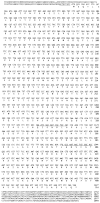NAC-1, a rat brain mRNA, is increased in the nucleus accumbens three weeks after chronic cocaine self-administration
- PMID: 9278521
- PMCID: PMC6573262
- DOI: 10.1523/JNEUROSCI.17-18-06864.1997
NAC-1, a rat brain mRNA, is increased in the nucleus accumbens three weeks after chronic cocaine self-administration
Abstract
Chronic cocaine use leads to biochemical and behavioral changes that can persist for weeks to months after drug administration is discontinued. Alterations in gene expression in the mammalian CNS may contribute to these long-term neural consequences of cocaine abuse. A combined in situ transcription-PCR amplification strategy was used to isolate a novel mRNA, NAC-1, from the nucleus accumbens of rats 3 weeks after discontinuing 3 weeks of intravenous cocaine self-administration. In rats that self-administered cocaine, levels of NAC-1 were increased approximately 50% in the nucleus accumbens but not in the dorsal striatum or hippocampus, when compared with levels from yoked-saline controls. In situ hybridization analysis demonstrated increased numbers of NAC-1-expressing cells in the nucleus accumbens of rats who had self-administered cocaine. NAC-1 mRNA exists as one form, approximately 4400 nucleotides (nt) in size, and also is present at much lower amounts in non-neural tissues. A full-length cDNA clone was isolated from a whole brain library. The predicted polypeptide sequence contains a POZ domain in the first 120 amino acids; the same POZ domain sequence mediates protein-protein interactions among some transcriptional regulators. NAC-1 mRNA levels were also increased in the nucleus accumbens 1 week after 6 d of noncontingent cocaine treatments. Regulation of NAC-1 mRNA in the nucleus accumbens demonstrates a long-term effect of cocaine use on cellular function that may be relevant in behavioral sensitization or cocaine self-administration.
Figures






References
-
- Albagli O, Dhordain P, Deweindt C, Lecocq G, Leprince D. The BTB/POZ domain: a new protein–protein interaction motif common to DNA- and actin-binding proteins. Cell Growth Differ. 1995;6:1193–1198. - PubMed
-
- Altschul SF, Gisg W, Miller W, Myers EW, Lipman DJ. Basic local alignment search tool. J Mol Biol. 1990;215:403–410. - PubMed
-
- Bardwell VJ, Treisman R. The POZ domain: a conserved protein– protein interaction motif. Genes Dev. 1994;8:1664–1677. - PubMed
-
- Bhat RV, Baraban JM. Activation of transcription factor genes in striatum by cocaine: role of both serotonin and dopamine systems. J Pharmacol Exp Ther. 1993;267:496–505. - PubMed
-
- Daunais JB, McGinty JF. Cocaine binges differentially alter striatal prodynorphin and zif/268 mRNAs. Mol Brain Res. 1995;29:201–210. - PubMed
Publication types
MeSH terms
Substances
Grants and funding
LinkOut - more resources
Full Text Sources
Molecular Biology Databases
Research Materials
